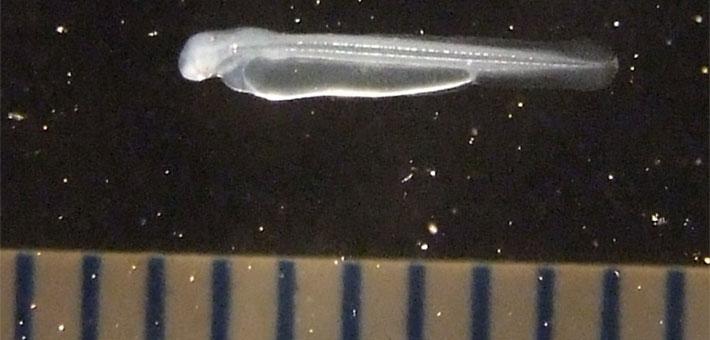
On June 18, 2015, three Silver Carp larvae were collected, approximately a mile-and-a-half upstream of the I-55 Bridge (Channahon, Illinois), in the Dresden Island Pool of the Des Plaines River (River Mile 279.3). These individuals ranged from 8.5 – 10.0 mm (0.33-0.39 inches) total length. Asian carp eggs (either Silver or Bighead Carp) were also identified from samples collected from Marseilles and Starved Rock pools of the Illinois River, as well as from downstream pools (LaGrange and Peoria). These detections are within areas that Bighead and Silver Carp have historically been captured; however, this is the first collection of larval fish upstream of Henry, Illinois (approximately 90 miles downstream on the Illinois River from this detection location in Dresden Island Pool). No additional Asian carp larvae were collected in this 90-mile stretch of the Illinois River in 14 sampling visits from April 27, 2015 to September 14, 2015.
Since 2011, as part of the Asian Carp Regional Coordinating Committee (ACRCC) Monitoring and Response Work Group Asian Carp Monitoring Plan, the Illinois Natural History Survey has been sampling for the presence and abundance of Asian carp eggs and larval life stages throughout the Illinois Waterway using 0.5 m diameter push nets with a 500µm mesh. While sampling throughout the year (April –October), weekly samples are preserved and returned to the lab for sorting and identification. Presumptive visual lab identifications for either of two Asian carp species (Bighead or Silver Carp) were made in August 2015 for the June 18, 2015 samples discussed here, and genetic analyses were necessary to confirm lab identification. For genetic confirmation, one of the assumed Asian carp larvae from the Dresden Island Pool and five Asian carp eggs from the Starved Rock and Marseilles pools, were sent to the US Geological Survey Upper Midwest Environmental Sciences Center for analyses. On November 2, 2015, US Geological Survey confirmed the larval specimen from the Dresden Island Pool as Silver Carp; all eggs from the Starved Rock and Marseilles pools were genetically identified as being Asian carp, either Bighead Carp or Silver Carp. More than 78,000 individual larval fish, including 62,170 larval Asian carp have been identified from samples collected in 2015, all at or downstream of Henry, Illinois (River Mile 190), except the three Silver Carp larvae confirmed in Dresden Island Pool, River Mile 280. Additionally, 71,367 Asian carp eggs have been identified from 2015 Illinois Waterway ichthyoplankton samples. More than 98% of Asian carp larvae and 55% of Asian carp eggs were collected in the downstream, LaGrange and Peoria pools. Given the estimated age of these larval fishes (200 hours) and the high flow in the waterway prior to and during the sampling period, a time-of-travel analysis of US Geological Survey streamflow gage data suggests that the larval fishes are not likely to have originated in the Chicago Area Waterway. However, alternative means of conveyance may have been utilized as this larval stage cannot move upstream or laterally on its own at this stage. Contamination or mislabeling of samples could also contribute to misinformation, but after review of these items, scheduling of sampling events, and proximity of like samples it is not evident this occurred. Finally, visual confirmation of attempted Asian carp spawning in the Marseilles Pool has occurred over the past three seasons; however, high river flows suggest any hatching of these eggs or movement of larvae from the drift are expected below Starved Rock Lock and Dam, where larval fish have been historically detected. No eggs were collected and identified as Asian carp in these prior years despite similar sampling events.

Sampling for larval fish continued throughout the 2015 summer months with no additional larval fish identified in upstream reaches. The ACRCC Monitoring and Response Plan continues to sample with a variety of small fish detection techniques in the Dresden Island, Brandon Road and Lockport pools, routinely finding no evidence of small fish in these most-upstream reaches, or near the U.S. Army Corps of Engineers Electric Dispersal Barrier system.
In a proactive response to this preliminary information, ACRCC Monitoring and Response Work Group agencies deployed electrofishing crews in the Dresden Island Pool with additional and substantial effort, deployed contracted fishers using a novel tool, a 200-meter small mesh seine designed to catch gizzard shad, a small native fish species that resembles Asian carp and inhabits their same niches. Furthermore, electrofishing efforts were used to drive fish into seines combining two effective sampling gears to maximize detections. These small meshed seine hauls were pulled in the Marseilles and Dresden Island pools. In all of the additional response efforts with these gears, no small Bighead or Silver Carp less than 6 inches were collected.
Given the concern about these findings, the Monitoring and Response Plan for 2016 is expected to contain heightened efforts to detect such spawning events, although the Monitoring and Response Work Group does not believe that either Asian carp species is established in the upper Illinois River. Monitoring efforts will also increase to further inform managers on the location and distribution of small Asian carp resulting from the recent record spawns in downriver locations and their movement above Starved Rock Lock and Dam.
Lastly, and most encouraging, is that Asian carp abundance in the most upstream pool in which they are found (Dresden Island), have shown significant declines in abundance (68%) between 2012 to 2014. This reduction is most likely attributed to contracted fish removal efforts. Recommendations to increase fish sampling efforts by 50% in this and other pools are being developed.